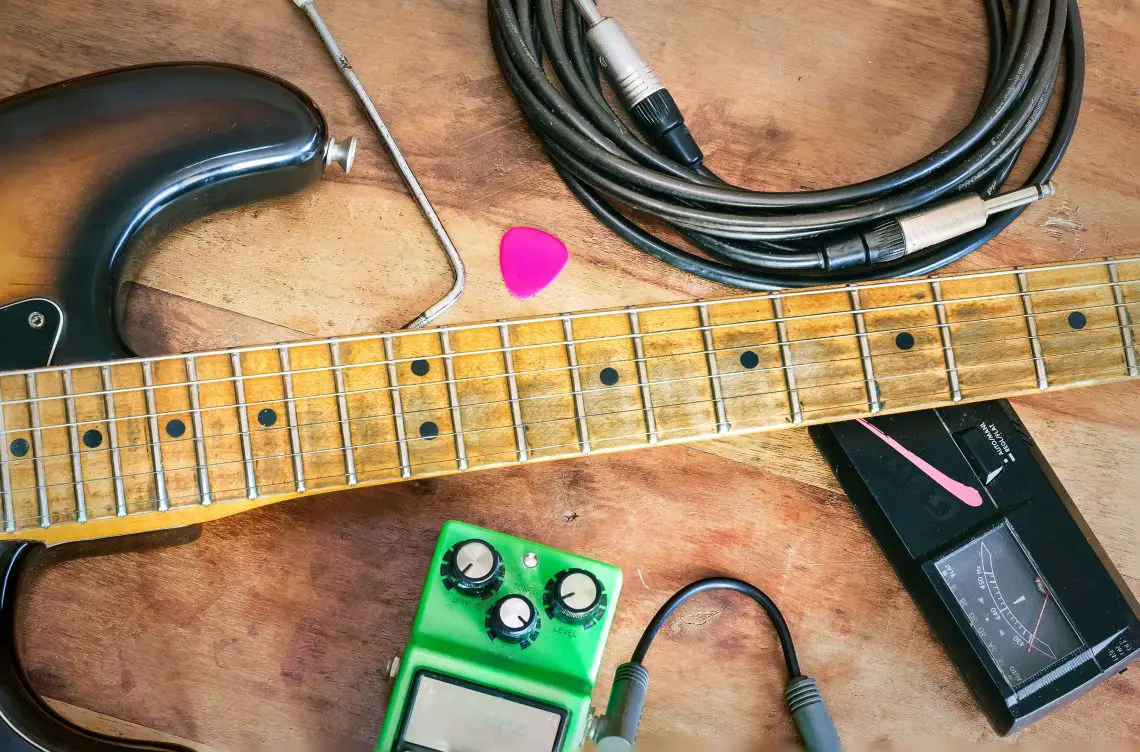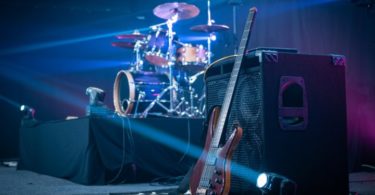Are you thinking about getting a semi-hollow body electric guitar?
Also called thinline guitars, they look the same as hollow body electric guitars from the outside. However, they have solid construction somewhere in the body. For example, the famous Gibson ES-335TD has a block of wood between the two hollow cavities on the top and bottom that runs through the center of the body.
Semi-hollow guitars produce less feedback, but have more sustain in their sound. So, if you’re looking for the best semi-hollow body electric guitar for your needs, this list should clarify things for you.
-
 Check on Musician's Friend Check on eBay
Check on Musician's Friend Check on eBayThe hollow chambers of the guitar between the maple top and bottom give a wooden resonance that is well suited for jazz and blues.
-
 Check on Amazon Check on eBay
Check on Amazon Check on eBayThe maple body sandwich construction of the ES-335 and comes with Alnico Pro pickups and Grover Rotomatic tuners.
-
 Check on Amazon Check on Musician's Friend
Check on Amazon Check on Musician's FriendGorgeously flamed maple bodies, abalone block markers, ebony fingerboards, gold hardware.
-
-
 Check on Musician's Friend Check on eBay
Check on Musician's Friend Check on eBayHas a center post rather that a full center block which offers additional resonance and warmth of tone.
-
 Check on Amazon Check on eBay
Check on Amazon Check on eBayMade entirely of laminated mahogany which is more midrangey and less bright than maple, which is a harder tonewood.
-
 Check on Amazon Check on eBay
Check on Amazon Check on eBayHas the bullet truss rod headstock access, which was an improvement over the need to remove the neck for warp prevention adjustments.
-
-
 Check on Musician's Friend Check on eBay
Check on Musician's Friend Check on eBayCapable of all types of expression thanks to the tremolo and luxuriously easy to play neck.
Electric Guitar Configurations for Beginners
Regarding the electric guitar, players have various pickup and wood options. However, there are only three basic configurations available:
- Full Hollow Body Electric Guitars: Jazz and some country musicians prefer full hollow body guitars for their warm, fat tones. But they are prone to feedback at higher volume levels. Also, they can lack the sustain and high-frequency response to cut through vocals, bass, drums and keyboards within rock and R & B groups.
- Solid Body Electric Guitars: The iconic Gibson Les Paul, Fender Telecaster, and Stratocaster are perfect for rock and most other styles of contemporary music. They deliver feedback suppression with searing tones at high volume.
- Semi-Hollow Body Electric Guitars: The neck of a semi-hollow body guitar attaches to a solid center block where the pickups, bridge, and tailpiece go. And the semi-hollow body electric guitar has a back and top that are hollow. This creates a resonance like a full hollow body, but with better sustain and feedback suppression. This versatile combination has made the semi-hollow electric guitar a favorite among musicians in all genres of music around the globe.
How to Choose a Semi-Hollow Body Electric Guitar
There are several other manufacturers who offer semi-hollow body electric guitar models, such as Reverend, Godin, Gretsch, Peavey, as well as other Gibson models, such as the P-90 equipped Blueshawk and ES Les Paul Special. However, for this list the comparisons are between “apples and apples.” This list looked at semi-hollow bodied humbucking pickup-equipped guitars and based some sonic references on the artists who use them.
Since playing comfort, sound preference, and cosmetic appearances are subjective elements, choosing the best semi-hollow body guitar should follow the same protocols for evaluation as with any instrument. Be sure to ask yourself these key questions first:
- Will this guitar inspire me to try new things?
- Will this instrument help me play better?
- Can I afford it?
- Is it a one trick pony or can I get different sounds from it?
- Will it work with my other gear?
Gibson Memphis ES-335
The hollow chambers of the guitar between the maple top and bottom give a wooden resonance that is well suited for jazz and blues.
History of the ES-335
In 1958, Gibson released the first semi-hollow body electric guitar: the ES-335. Designed with a wooden sustain block sandwiched between a maple top and back, the ES-335 is an amazingly versatile instrument. Countless artists of all musical genres have played it over the years. The ES-335 and its sisters, the 345 and 355, have turned up in the hands of countless artists, including Chuck Berry, Keith Richards and Eric Clapton.
Other musician fans of the ES-335 are Dave Grohl, Paul Simon, Vince Gill and Keith Urban. Studio ace Larry Carlton became famous as “Mr. 335” due to his distinctive ES-335 into overdriven Fender, Mesa and Dumble amps on classic records, including Steely Dan.

Credit: Gibson Brands, Inc
Top Features of the ES-335
The ES-335 has a double cutaway, twin “F” hole design that has become a classic. It combines the warmth of a hollow body with the sustain and edge of a Les Paul solid body. This guitar has classic 57 humbucking pickups, a 24.75” bound neck and nickel-chrome hardware, with either Kluson or Grover tuners.
They mounted the Gibson Tune-O-Matic bridge and stop tailpiece into the sustain block from the top. This gives the ES-335 its Les Paul type rock sounds and feedback resistance at high volumes. The hollow chambers of the guitar between the maple top and bottom provide a wooden resonance well suited for jazz and blues.
You can get an infinite number of tonal colors just from the two pickups using the tone and volume controls. The ES-335 Studio model has an unbound neck, but only has a master volume and tone. Although it costs almost $1,500 less, you sacrifice sound tweaking capability.
Some Final Words on the ES-335
Like other iconic guitars of the 1950’s like the Fender Telecaster and Stratocaster, Gibson has practically unaltered the Gibson ES-335’s design since its origin in 1958. This is a testament to the genius of Ted McCarty, who was also responsible for Gibson’s Flying V, Firebird and Explorer models. Almost every other guitar manufacturer of semi-hollow guitars has copied its design because it was the first. On the plus side, the sound of this semi-hollow body electric guitar is instantly recognizable and a joy to play.
Conversely, the ES-335 is a considerable investment and could be too expensive for most musicians.
Epiphone Dot
The maple body sandwich construction of the ES-335 and comes with Alnico Pro pickups and Grover Rotomatic tuners.
History of the Epiphone Brand
Gibson has owned Epiphone since the 1960’s, and the company has had a number of prized guitars under their own label. They also serve as the import line for Gibson’s classic models from Korea, China and Indonesia. The Beatles are probably the best-known players of the Epiphone Casino.
Although it resembles the ES-335, it is a fully hollow bodied thinline guitar. Epiphone named this guitar the Dot as a tribute to the original 1958 Gibson ES-335. For budget-minded players, the Epiphone Dot delivers much of the ES-335 sound and vibe at a fraction of the cost.

Credit: Epiphone
Top Features of the Epiphone Dot
They build the Dot at the Epiphone Qingdao factory and it shares the maple body sandwich construction of the ES-335. The Dot also comes with Alnico Pro pickups and Grover Rotomatic tuners. While its sound lacks the complexity of its namesake when you play it directly into an amp, the Dot plays great. However, when you use it with pedals, you won’t notice any sonic differences on a cursory listening.
Some Final Words on the Epiphone Dot
The Epiphone Dot is roughly eight times less expensive than the Gibson ES-335.
For tighter budgets, the Dot Studio, which has open-coil humbucking pickups and single tone and volume knobs, has lots of guitar bang for the buck.
And if you want to buy a used one, the Korean semi-hollow body electric guitar models from before 2005 are often from the Samick or Peerless factories. And musicians highly regard them, so they may hold better resale value. For players who like pearl inlays and gold hardware, the Epiphone Sheraton II, which counts U2’s The Edge, Noel Gallagher and Kings of Leon’s Matthew Followhill among its fans, is also worth a look.
Ibanez Artstar AS153
Gorgeously flamed maple bodies, abalone block markers, ebony fingerboards, gold hardware.
Hoshino Gakki of Japan has made guitars under several brand names since after World War II. However, in Europe, they offer them under the Greco name and as Ibanez in America. Ibanez captured a sizable market presence for their excellent Gibson and Fender copies, including musicians like Tom Petty and Paul Stanley. But in the 70’s, Gibson filed a lawsuit over copyright infringement.
However, Gibson’s action launched Ibanez’s foray into original designs. This sparked Ibanez to create new innovations, attracting thousands of players. In addition to their huge following in the heavy metal and rock arenas, Ibanez has developed a strong presence among jazz, acoustic and bass players.
Since they have offered signature guitar models by George Benson, Pat Metheny, Paul Stanley and Bob Weir, as well as Ani DeFranco and Herman Li. And the guitars by Steve Vai and Joe Satriani have become bestsellers.

Credit: Ibanez guitars
Top Features of the ArtStar AS153
For several decades, the Ibanez Artist and Artstar (AS) series have offered semi-hollow body electric guitar models as good or better than U.S. models. The Ibanez Artist solid body offered the first alternative to the Les Paul in the mid-70’s. Also, it gained the endorsement of the then red-hot Steve Miller. And the Ibanez Artist AS200 and AS100 semi-hollow models quietly made their own sterling reputation.
The Artstar line offers gorgeously flamed maple bodies, abalone block markers, ebony fingerboards and gold hardware. Ibanez added some innovations, such as their slotted Quik Change tailpiece, ABR-1 bridge and Velve Tune machine heads. Also, the sure grip knobs and buttery sounding Super 58 Tri-Sound pickups pose serious challenges to the supremacy of the ES-335.
The Artstar delivers a comparable profile and feel to the ES-335. And the AS sound, courtesy of the Ibanez Tri Sound design, gives players a choice of single coil mode, series, or parallel mode. These features were only available during the 70’s only as a custom wiring scheme from companies like Alembic. They were rare as standard equipment in an affordable professional quality guitar.
Some Final Words on the ArtStar AS153
The AS semi-hollow series has garnered thousands of fans in the last several decades. However, the most famous proponent is jazz guitarist John Scofield. Ibanez based his signature Ibanez model on the stock AS200 that he has played for over 20 years.
The current AS153 series is the vintage sunburst semi-hollow body electric guitar model. It is practically identical to the original, except that they make it in China rather than in Japan to keep costs under control. This is a fabulous bargain for someone seeking the semi-hollow mojo.
The Japanese-made AS200 is still available as part of the Ibanez Prestige series. However, it costs approximately 115 percent more. Even so, that’s still less expensive than a new ES-335. And it is also a better value in the eyes of its legion of fans.
Ibanez Artcore ASV10
Offer much of the Super 58’s throaty voice but without the Tri Sound options.
Ironically, Ibanez made its breakthrough in the Western markets on the strength of its copies of classic Gibson and Fender models. But now, they make copies of their own popular designs in less labor-expensive nations, like China and Indonesia. And the Ibanez Artcore ASV10 is a great example of a quality semi-hollow body electric guitar.

Credit: Ibanez Guitars
Features of the Artcore ASV10
Sporting a similar maple body construction, the ASV10 also has abalone markers and sure grip knobs. But, it has chrome rather than gold plated hardware, including the Quik Change tailpiece and ABR-1 bridge. Otherwise, it has the more conventional Ibanez tuners and a rosewood fingerboard. The Ibanez Classic Elite pickups offer much of the Super 58’s throaty voice without the Tri Sound options.
Final Words on the Artcore ASV10
The Artcore ASV10 is a viable low-cost alternative to the Epiphone Dot. It is a good value for semi-hollow electric guitar players who prefer the Ibanez feel and sound over that of Gibson or Epiphone.
D’Angelico EXL-SS
Has a center post rather that a full center block which offers additional resonance and warmth of tone.
John D’Angelico built his guitars in New York City and set a standard of artistic craftsmanship excellence. In fact, today’s top luthiers, such as Robert Benedetto, John Buscarino and John Monteleone still consider his skills to be the pinnacle. But roughly five years ago, Steve Pisani purchased and licensed the D’Angelico name for a new line of high-quality guitars.
They wanted to import guitars from Korea and base their custom shop in New York. The new D’Angelico company offers fully hollow jazz models that feature many of the attributes of the top classic archtop models John D’Angelico created. They also provide several semi-hollow single and double cutaway designs. These new models have found favor with many artists, including Susan Tedeschi, Bob Weir, Warren Haynes, Brad Whitford and Kurt Rosenwinkel.

Credit: D’Angelico Guitars
Top Features of the D’Angelico EXL-SS
Unlike their double cutaway model, the D’Angelico EXL-SS is a single cutaway laminated flame maple bodied semi-hollow model. It is available with either a stop tailpiece or the signature D’Angelico stairstep trapeze tailpiece. The stairstep trapeze tailpiece has a center post rather that a full center block. This feature offers additional resonance and warmth of tone.
The EXL-SS also has high output Kent Armstrong humbucking pickups, mother of pearl block markers and headstock inlays. And the gold-plated Grover Imperial Super Rotomatic tuners like many high-end jazz archtops, gives the EXL-SS evidence of its illustrious pedigree. It can gush out an array of tones equally at home across the musical spectrum from jazz to blues to country to rock.
Some Final Words on the D’Angelico EXL-SS
Although they make it in Korea, the EXL-SS is an excellent semi-hollow bodied guitar with a unique voice and feel that warrants serious consideration.
Guild Starfire IV
Made entirely of laminated mahogany which is more midrangey and less bright than maple, which is a harder tonewood.
In 1952, Albert Dronge started Guild Guitars in New York City, with its first guitars premiering the following year. Dronge’s passion for jazz dictated the Guild product line. They produce classic full hollow bodied archtop models, such as the Johnny Smith Award signature model, X-175 Manhattan and the M-75 Aristocrat.
Also, Guild offers several flattop models to serve the burgeoning folk music market. The Guild brand has become synonymous with their industry-leading unmatched jumbo 12 string models. Additionally, their various Guild acoustic and electric models have found themselves in the hands of Slash, Duane Eddy and David Byrne. Other fans have included Richie Havens, John Denver, Tom Petty and Muddy Waters.
Fender bought the company in 1995 and in 2014, they sold it to Cordoba Guitars. They have resumed U.S. manufacturing since 2015 after outsourcing to Korea and China when they shut down their Hartford, Connecticut factory. Their Starfire series feature thinline hollow body and semi-hollow body electric guitar models. And their single cutaway Starfire II and III models are fully hollow like the Epiphone Casino. And lastly, Guild’s double cutaway IV and V models are semi-hollow.

Credit: Guild Guitars
Top Features of the Starfire IV
The Starfire IV is popular model with blues players such as Buddy Guy and Son Seals. And although it looks like the ES-335, it has several differences that contribute to its unique sound. Guild made the Starfire IV entirely of laminated mahogany. It is more midrangey and less bright than maple, which is a harder tonewood.
The Starfire bridge is a rosewood based floating Tune O Matic like on full hollow bodied archtops. And the signature Guild trapeze tailpiece has a cutout of the Guild “G” shield logo at its base. The LB-1 pickups are recreations of the vintage “Little Buckers” Guild offered in the early 60’s. They offset the darker sounding mahogany with their somewhat brighter and more jangly output.
The combination of brighter pickup with darker tonewood gives the Starfire a distinctly different voice from maple bodied humbucker equipped semi-hollow guitars. It can go from round and warm to sharp and nasal easily. Many players appreciate the tonal choices they can achieve with this guitar.
The tuners are open geared Grover Sta-Tites, which resemble the vintage units of the past. However, they provide much more reliability and a finer gear ratio. And finally, the Starfire V is like the Starfire IV, except for the Bigsby vibrato instead of the trapeze tailpiece.
Some Final Words on the Starfire IV
With an impressive history and a unique sound, the Guild Starfire IV has made its own mark in the semi-hollow body electric guitar world – and the Korean made Starfire IV won’t break the bank. It gives modern guitarists a palette to combine classic and modern sounds in new ways without repeating the ones their predecessors used.
Fender 72 Telecaster Thinline
Has the bullet truss rod headstock access, which was an improvement over the need to remove the neck for warp prevention adjustments.
History of Fender Guitars
Leo Fender is an American musical instrument pioneer because he created the first commercially-available electric bass, the Fender Precision Bass. He also built a commercially-available solid body electric guitar, the Fender Telecaster. Fender Musical Instruments designed the Telecaster Thinline 72 during its much-maligned CBS era. They did this to compete with the semi-hollow bodied guitar ES series from Gibson.
However, in an earlier 1966 attempt, the disastrous dyed wood Coronado Wildwood series was a major flop. So, in 1968, The Telecaster Thinline made its debut. It had a chambered Telecaster body with an F hole. It retained the maple Telecaster neck with a skunk stripe, which is a routed channel in the neck for the adjustable truss rod.
Also, it had the same single coil pickups found in the solid body Telecaster, including the bridge assembly with adjustable three saddles. The pickguard, which was enlarged to cover the chamber routs, was plastic with a faux pearl finish.
Features of the Thinline 72
The Thinline 72 had a similar ash body and neck construction as the Telecaster. But instead of the Telecaster single coils, it sports a pair of Seth Lover-designed Wide Range humbucking pickups. Additionally, it has bullet truss rod headstock access, which eliminates having to remove the neck for warp prevention adjustments.
The maple neck has the familiar skunk stripe and sports a 7.25-inch radius. Also, the bridge has six individually adjustable saddles. This provides players with more fine tuning options for intonation over the entire fretboard. At the time, the Fender sound was famous for their bright sounding single coil pickups, while Gibson was famous for their fatter humbucking pickup sounds.
Although lighter in weight than a solid body Telecaster, the Thinline 72 semi-hollow body electric guitar retains a good portion of the classic Telecaster sound. However, it has a tendency to feed back more readily at high volume levels. The humbucking pickups are more resistant to noise from fluorescent lights and RF signals than single coils.
The Thinline 72 was an unsuccessful offering at first, as the market preferred the classic Tele solid body single coil sound. Still, Blues prodigy, Jonny Lang, the late Curtis Mayfield, Sly Stone, Tab Benoit and Bill Frisell are noted Thinline players. Time has since changed attitudes, so Fender has reissued limited runs of its CBS era guitars for a new generation of players.
Some Final Words on the Thinline 72
Fender builds the Thinline 72 in their Mexican factory. It is an excellent reissue of the original model, which was not a big seller at first. It is affordable by average guitar pricing standards. And while its sound and look are similar to that of a Telecaster, the Thinline 72 has wide range humbuckers that offer different aural flavors to the Fender tone.
For those seeking a different look, but a similar sound, the Fender Starcaster reissue is also worth a try.
Squier Vintage Modified Telecaster Thinline ‘72
Almost identical to its Fender cousin.
History of Squier Guitars
Fender formed the Squier brand in the 1980’s after an employee-led buyback from CBS. The Squier brand originally sourced Japanese and Korean Fender copies for importing to the U.S. and European markets. Manufacturing costs and quality control became more exacting, so Fender sourced its high-end brands from Japan and Korea as their Mexican factory expanded.
They include the Gretsch and certain Fender models the Custom Shop didn’t offer. Squier now sources their Vintage, Classic Vibe and Standard models from China and their Affinity and Bullet series from Indonesia.
Features of the Vintage Thinline 72
Squier’s Vintage Modified Telecaster Thinline 72 semi-hollow body electric guitar almost identical to its Fender cousin. The exception is the 9.5-inch fingerboard radius. Also, it has a stamped rather than a die cast bridge and saddle hardware. Its sound is certainly in the Fender family, though. In fact, the Squier Wide Range humbuckers look like the original Seth Lover design.
Some Final Words on the Vintage Thinline 72
The Squier Thinline 72 lives up to the reputation of the Vintage Modified series, which includes the excellent 75 Jazz Bass, Jazzmaster, Jaguar and Telecaster Custom models.
Similar to the Epiphone Dot equivalent, you may notice some differences in the discounted cousin when you plug it straight into an amp. But, if you play it through a pedal board, the differences are much more difficult to discern.
Paul Reed Smith S2 Custom 22 Semi-Hollow
Capable of all types of expression thanks to the tremolo and luxuriously easy to play neck.
Paul Reed Smith is the most recent American boutique guitar manufacturer to break into the mass market appeal. Smith has done so by an almost obsessive dedication to quality control on his original designs. Many PRS guitars are custom shop AAAA flamed or quilted maple topped models with price tags of $6,500 and up.
However, Smith also offers other models with humbler cosmetics without the significant sacrifice of playability or tone. Carlos Santana, Dave Navarro, Neal Schon, Alex Lifeson, and Mark Tremonti are just a few of the hundreds of PRS artists today. The S2 Custom 22 Semi-Hollow semi-hollow body electric guitar is a prime example of the PRS ethic.

Credit: PRS Guitars
Features of the S2 Custom 22
The S2 Custom 22 Semi-Hollow has a single “F” hole in a semi hollow chambered mahogany body and flamed maple cap. It also has PRS custom designed pickups, such as the #7 or 85/15 series, both of which are on much more expensive PRS models. The single volume and tone knobs offer push/pull coil splitting functions and a Telecaster style three-way blade switch. The tremolo is also PRS designed, as are the locking tuners.
The Custom 22 has the asymmetrical signature PRS body shape and the Les Paulish “pattern regular” mahogany neck on a 25” scale instead of the famous wide, thin profile on PRS 24 fret models. And the pearl doves in flight markers inlaid on the Custom 22 rosewood fingerboard includes the same attention to detail Smith devotes to his custom guitars.
The sound of the S2 Custom 22 Semi Hollow is pure PRS. It is full of fat tones with snap, but capable of all types of expression thanks to the tremolo and luxuriously easy to play neck. The chambered body gives the Custom 22 semi-hollow semi-hollow body electric guitar an added resonance and warmth that its solid body cousin lacks. But it trades that off with an extra bite and growl inherent in the solid Custom 22 model.
Some Final Words on the S2 Custom 22 Semi-Hollow
The S2 Custom 22 Semi Hollowsemi-hollow body electric guitar is a bargain for a U.S.-made guitar, especially for one as finely crafted as a PRS. For those seeking comparable PRS quality in a more affordable package, the SE series, made with the same high quality control standards, offers the Paul Reed Smith SE Custom 22 Semi Hollow. Although it has a wraparound bridge tailpiece instead of the tremolo, this Korean PRS delivers the S2’s sonic punch at a more affordable price.
In Conclusion: A Semi-Hollow Electric Guitar Comparison
All of these semi-hollow body electric guitar models have their merits. While the Gibson ES-335 sets the bar for semi-hollow body electrics, the Ibanez Artstar AS153, the D’Angelico EXL-SS and the PRS S2 Custom 22 are worthy choices while not breaking the bank. The Guild Starfire IV is in a different aural space due to its mahogany construction and LB-1 pickups but is no less of a guitar. For the budget minded, the Epiphone Dot, PRS SE Custom 22 and Ibanez ATV-10 are all excellent semi-hollow body electric guitar options, as well.
And the Fender 72 Telecaster Thinline and Squier Vintage Modified Telecaster Thinline 72 guitars are all Fender sounding. Also, they maintain the debate between Gibson and Fender-type guitars, even though they also sport humbucking pickups. For the Fender player who wants the familiar comfort of a Fender maple neck, but a little semi-hollow warmth, these models are just what the doctor ordered.
And if you prefer the widest range of sounds from a single instrument, the Ibanez Artstar and the PRS S2 Custom 22 are famous for their pickup coil tap and other variations. For a broad sonic palette when you only have one guitar, coil splitting or series and parallel pickup options can save money and preserve your reputation as a musician.
To recap, here’s the full competition:
The hollow chambers of the guitar between the maple top and bottom give a wooden resonance that is well suited for jazz and blues.
The maple body sandwich construction of the ES-335 and comes with Alnico Pro pickups and Grover Rotomatic tuners.
Gorgeously flamed maple bodies, abalone block markers, ebony fingerboards, gold hardware.
Offer much of the Super 58’s throaty voice but without the Tri Sound options.
Has a center post rather that a full center block which offers additional resonance and warmth of tone.
Made entirely of laminated mahogany which is more midrangey and less bright than maple, which is a harder tonewood.
Has the bullet truss rod headstock access, which was an improvement over the need to remove the neck for warp prevention adjustments.
Almost identical to its Fender cousin.
Capable of all types of expression thanks to the tremolo and luxuriously easy to play neck.












Start the discussion at talk.hearthemusicplay.com